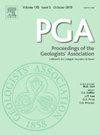Deformation of terrace surfaces in the Bystrzyca River valley, central Sudetic Foreland, SW Poland
IF 1.2
4区 地球科学
Q2 Earth and Planetary Sciences
引用次数: 0
Abstract
This article addresses the development of Pleistocene terraces in the Bystrzyca River catchment (Sudetic Foreland, Southwestern Poland) in the vicinity of the Sudetic Marginal Fault, within the Roztoka–Mokrzeszów Graben. Nineteen research sites located within the Świdnica Plain are documented in this paper, representative of terraces of the Bystrzyca and its Piława and Witoszówka tributaries, with reporting on analyses of structure, grain size, petrography, quartz-grain morphoscopy, and heavy minerals. The Bystrzyca River, flowing in the largest and deepest valley in the Sowie Mountains, crossing the fault zone and extending into the Sudetic Foreland, has been influenced by significant tectonic and glacial events. During the Middle Pleistocene a fluvial piedmont fan was formed and survives as traces of higher-level (pre-Saalian) terraces. The main fluvial terraces are recognized as follows: an Upper Terrace, from the Saalian, a Middle Terrace from the Upper Pleistocene Last Glacial (Weichselian) and, in the valley bottom, a Lateglacial–Holocene Lower Terrace and a Holocene Lowermost Terrace. The sediments forming these terraces document a complex history of tectonic uplift, glacio-isostatic rebound, and climatic changes. Notable features include a sequence of alluvial fans and terraces shaped by neotectonic activity, particularly during the Late Quaternary.
波兰西南部苏台德前陆中部Bystrzyca河谷阶地表面的变形
本文讨论了Roztoka-Mokrzeszów地堑内苏德边缘断裂附近的Bystrzyca河流域(苏德前陆,波兰西南部)更新世阶地的发育。本文记录了位于Świdnica平原内的19个研究地点,这些地点代表了Bystrzyca梯田及其Piława和Witoszówka支流,并报告了结构、粒度、岩石学、石英颗粒形态和重矿物的分析。Bystrzyca河流经索伊山脉最大最深的山谷,穿过断裂带,延伸至苏德特前陆,受到了重大的构造和冰川事件的影响。在中更新世期间,形成了一个河流山前扇,并作为更高层次(前萨利安)梯田的痕迹保存下来。主要的河流阶地有:萨利安期的上阶地,末次冰期的上更新世的中阶地,河谷底部的冰川-全新世下阶地和全新世下阶地。形成这些阶地的沉积物记录了构造隆起、冰川均衡反弹和气候变化的复杂历史。其显著特征包括一系列由新构造活动形成的冲积扇和阶地,特别是在晚第四纪。
本文章由计算机程序翻译,如有差异,请以英文原文为准。
求助全文
约1分钟内获得全文
求助全文
来源期刊
CiteScore
2.70
自引率
8.30%
发文量
54
审稿时长
6-12 weeks
期刊介绍:
The Proceedings of the Geologists'' Association is an international geoscience journal that was founded in 1859 and publishes research and review papers on all aspects of Earth Science. In particular, papers will focus on the geology of northwestern Europe and the Mediterranean, including both the onshore and offshore record. Following a long tradition, the PGA will focus on: i) a range of article types (see below) on topics of wide relevance to Earth Sciences ii) papers on aspects of Earth Science that have societal relevance including geoconservation and Earth management, iii) papers on palaeoenvironments and palaeontology of the Mesozoic and Cenozoic, iv) papers on aspects of Quaternary geology and climate change, and v) papers on the history of geology with particular reference to individuals that have shaped the subject. These topics will also steer the content of the themes of the Special Issues that are published in the PGA.

 求助内容:
求助内容: 应助结果提醒方式:
应助结果提醒方式:


